
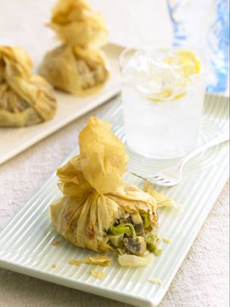 Phyllo purses: stuffed phyllo dough wrapped in knots. Photo courtesy of MushroomInfo.com. Phyllo purses: stuffed phyllo dough wrapped in knots. Photo courtesy of MushroomInfo.com.
June 2009
Last Updated September 2025
|
 |
Pastry Glossary
Phyllo Dough & Other Types Of Pastry & Pies
Page 8: Definitions With Pe To Pu
This page discusses kinds of pastry such as phyllo dough, plain pastry, and puff pastry. This is Page 8 of a ten-page glossary. Click the black link below to visit other pages. See our 100+ food glossaries, each featuring a different favorite food.
PEANUT BUTTER PIE
There are many variations on the theme of a peanut butter pie. Some are so dense and sweet that they are Reese’s Peanut Butter Cup ported into a pie crust, mixing cream cheese with peanut butter to create a cheesecake-like density. Others whip the PB into a mousse-like filling. Some use smooth PB, some use crunchy, and some make their own. Purists maintain that a peanut butter pie should be strongly flavored with peanut butter and nothing else, with a light consistency (think peanut butter pastry cream). Most everyone will agree that the crust should be chocolate! Some use cookie crumbs, some make a chocolate tart dough. Variations include lining the base with ganache and toasted peanuts.
PECAN PIE
A very rich pie made with a plain pastry and pecans bound in a rich filling of eggs, brown or white sugar, corn syrup, and vanilla. Sometimes, Bourbon is added. It is traditionally garnished with whipped cream. Chocolate pecan pie uses chocolate wafer crumbs for the crust and optional chocolate morsels in the filling. Pecan pie is a 20th-century invention; no recipes have been found dated earlier than 1925; earlier references to pecan pie, dating back to the 1800s, used a milk-based custard. According to FoodTimeline.com, The Fannie Farmer Cookbook and The Joy of Cooking did not include recipes before 1940. The Karo Syrup website claims that the pie was invented by the wife of a Karo corporate sales executive in the 1930s. Try these recipes for sweet potato pecan pie with Jack Daniel’s (instead of Bourbon) and Bourbon pecan pumpkin pie.
|
|
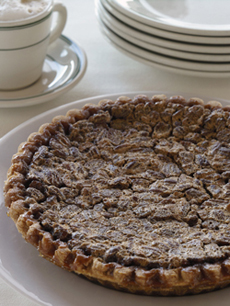
One of America’s favorite desserts, pecan pie. Photo courtesy of Joe’s Seafood, Prime Steak and Stone Crab in Chicago. |
|
PHYLLO or FILO DOUGH or PHYLLO PASTRY
Phyllo (FEE-low) is the traditional dough of the Greek and Middle Eastern cuisines, for sweet and savory pastries including the famous baklava (with honey and nuts) and spanakopita (spinach and feta).
Phyllo means “leaf” in Greek and refers to the many tissue-thin leaves (so thin you can read through them), or sheets, of pastry dough that comprise the dough. Traditionally, the dough was made by hand by gently rolling, stretching, or pressing it into the ultra-thin sheets. Now it is made by machine and is available ready-made. In preparation for baking, the dough is brushed with butter or oil; it must be worked with quickly as it dries with exposure to air. It can be cut into sheets and layered in a tin, cut into individual rolls, or rolled up as one large roll. See also puff pastry and strudel.
Greeks have been eating cheese pies, sweet and savory, since ancient times. One of the earliest references to one comes from the poet Philoxenos in the fifth century B.C.E., who describes a cheesecake made with milk and honey that was baked like a pie [source]. Both phyllo and spinach arrived in Greece sometime during the Byzantine era (from 330 to 1453 B.C.E.).
|
|
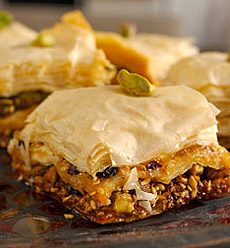
Michael Recchiuti’s baklava. See the recipe.
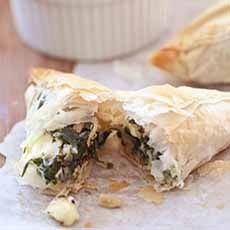
Spanokopita, a savory pastry made with spinach and feta cheese, is another popular example of phyllo pastry. Here’s a recipe.
|
PIE
A pie is a pastry with a sweet or savory filling (cream, custard, fruit, meat, pudding, meat, or vegetable). Sweet pies are generally served as desserts, and savory pies as the main course or appetizer. Pies can have bottom crusts only, top and bottom crusts, or, as with deep-dish pies, only a top crust. The crusts are sloped, not straight. Crusts are crisp and flaky and made from a variety of recipes, depending on the desired effect.* Pies are served straight from the dish in which they were baked, as opposed to tarts, which are removed from the baking tin. See pastry and the difference between pies and tarts.
*A pie crust is traditionally made of flour, salt, cold water, and a shortening: butter, lard, vegetable shortening, or other fat. Some recipes use a combination. The goal is a crisp, flaky crust.
|
PIECAKEN
Created in 2015 by pastry chef Zac Young and his team, PieCaken is the dessert version of turducken. The three-layer confection consists of layers of pecan pie, pumpkin pie, and apple upside-down cake, along with cinnamon buttercream. The dessert proved so popular that it was made in Christmas, Valentine’s, St. Patrick’s Day, and Passover versions, among others, including special commissions. Here’s the history of PieCaken and a recipe to make a fall version.
|
|
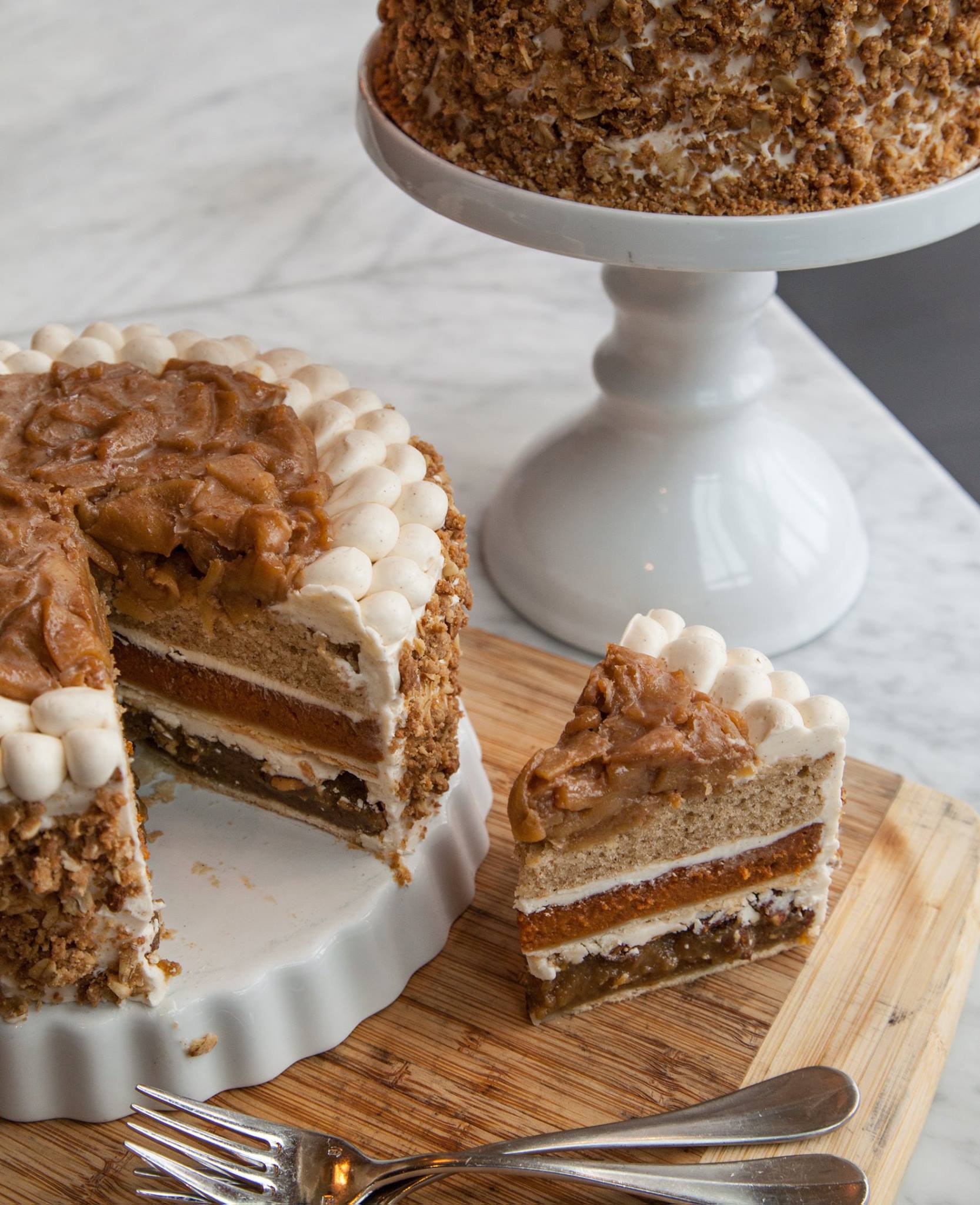
Zac Young’s first PieCaken, for Thanksgiving: a layer of pecan pie, pumpkin pie, and apple upside-down cake. Here’s the recipe (photo © PieCaken Bakeshop). |
PIE CRUST
The most basic pie crust is made with flour and water; fat can be added to make a finer pastry crust. Medieval cooking texts refer to the crust as the “coffin”; a pie crust with very thick walls was often used as the cooking receptacle—no pie plate needed. These tall, straight-sided pies appear in Dutch and French paintings; meats, fruits, and sauces were layered inside. Later, tin pie plates appeared, although poor housewives made do with soup bowls, dinner plates, and pots—the origin of the “pot pie”; the pot later gave way to deep-dish pie plates.
There are 5 basic types of pie crust:
- Crumb crusts, which use cookie crumbs and melted butter instead of dough. Beyond cookies, you can use cereal, crackers, nuts, and more.
- Flaky pastry crusts, the most popular pie crusts in the U.S.
- Hot water pastry crusts, made for savory fish or meat pies, using lard or beef drippings as the fat (some recipes use butter or shortening).
- Shortcrust pastry, a French-style dough that’s used for pies, tarts, and quiches.
- Other crusts have evolved to make creative use of ingredients: crushed ice cream cones or pretzels; shredded cheese, coconut, or potatoes; leftover grains, and so on.
|
PIE GATE
This ingenious invention keeps the filling from spilling out of a cut pie. It has a center hinge that opens to any angle until the last piece is gone! The gate can also be used to contain runny cheeses like Brie and Camembert.
PIE PASTRY
See pastry.
|
|
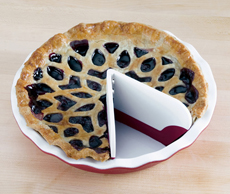
Pie gates are available online. Photo © Chefs. |
|
PIE WEIGHTS
Pie weights are used when baking pastry shells to keep them bubble- and shrink-free. Pierce the unbaked shell, cover it with parchment paper or foil, and fill it with the pie weights before baking. The reusable weights prevent uneven rising. The ceramic weights shown in the photo produce much better results than the “home remedy” of beans.
|
|
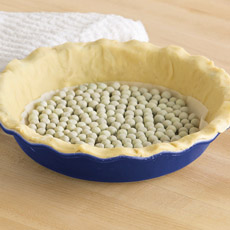
Pie weights, or beads, are also available in an easier-to-remove bead chain. Photo © Chefs. |
|
PIGNOLATA
Pignolata is a cake-sized Sicilian pastry (pignulata in the Sicilian dialect) made of fried balls of dough, held together with honey. The regular size of pignolata Siciliana (top photo) is meant to serve several people, although miniature, individual pastries are also made. They are typically sprinkled with chopped almonds or hazelnuts, although in modern times, as the photo shows, candy sprinkles are often used. A “black and white” version of the pastry, pignolata Messinese (from Messina), is half covered in chocolate and half covered in lemon syrup or icing. In other regions, chocolate and vanilla are used. Pignolata crossed the Strait of Messina and also became common in Calabria.
PLAIN PASTRY
Plain pastry is made from pastry flour or all-purpose flour, salt, and fat, which can be butter, lard, or vegetable shortening. The ingredients are cut with a pastry blender or two knives (or even with fingers) until it is in bits the size of peas; then the bits are sprinkled with ice water and lightly patted—never kneaded, which makes a dough too tough for tender pastry—into a ball. The ball is chilled and rolled out. Leftover scraps of dough can be used to make cheese straws.
|
|
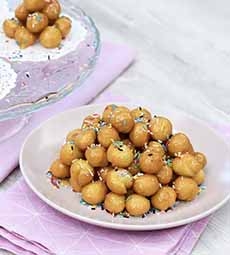
Pignolata Siciliana, regular and individual sizes (photo © Tuorlo Rosso).
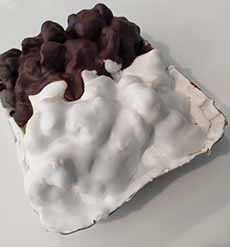
Pignolata Messinese from Pasticceria Raffaele Antonio. |
|
POSSUM PIE
Possum pie is a no-bake layered pie that originated in Arkansas, where it has achieved cult status. It does not contain possum meat; the name comes from the concept of “playing possum,” because the idea is that the pie is deceptive in appearance. The thick layer of whipped cream on top conceals what’s going on underneath: layers of chocolate pudding and cream cheese filling over a pecan shortbread crust. The pie is also known by other names, including The Next Best Thing to Robert Redford, Four-Layer Delight, and Five-Layer Delight. Here’s a recipe.
|
|

Possum pie, a layered, no-bake pie (photo © Taste Of Home). |
|
POT PIE or POTPIE
As opposed to a meat pie, which is simply a savory two-crust pie of minced meat in plain pastry, a pot pie is a stew baked inside two flaky crusts. Beef, chicken, or turkey are most popular, including chunks of the meat plus mixed vegetables (potatoes, carrots, green beans, and peas) in a gravy. The term evolved from the early use of a pot as the baking receptacle; the deep dish pie plate evolved later. See pie crust. We’re addicted to the chicken pot pie from Twin Hens.
|
|
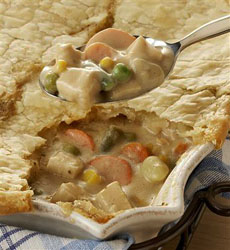
Chicken pot pie. Photo courtesy McCormick. This and other recipes are available at McCormick.com. |
PUFF PASTRY or CHOUX PASTRY or PÂTE À CHOUX or LAMINATED PASTRY
Puff pastry is a light, flaky, and tender pastry made by mixing flour, salt, chilled butter (or other fat), and water to form a dough. This is the process of making short pastry as well. However, with puff pastry, the dough is then layered with butter, rolled out, folded into thirds, and allowed to rest.
This process, which is repeated 6 to 8 times, produces a pastry comprising hundreds of layers of dough and butter. When baked, the moisture in the butter creates steam, causing the dough to puff and separate into hundreds of extremely thin and delicate, flaky layers. Puff pastry is used for delicate pastries like cream puffs, éclairs, napoleons, and some Danish pastries; for sweet and savory pies and vol-au-vents; for cookies such as palmiers; and for breakfast breads such as croissants and pain au chocolat. It is also used as a wrapping pastry for dishes en croûte.
|
|
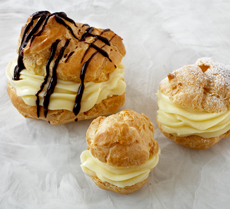
Cream puffs. Photo courtesy American Egg Board. |
|
PUMPKIN PIE
Pumpkin pie is a pumpkin-flavored custard pie. Pumpkins are a New World food (along with chiles, corn, peanuts, potatoes, tomatoes, turkey, and other favorites. While some foods like tomatoes took generations to be accepted, pumpkins (often called pompions in old literature) were similar enough to Old World squash, delicious and easy to grow. The Native American tribes of the Northeastern U.S. were big consumers of pumpkin and other squash, which they baked and turned into soup. The Pilgrims brought the concept of pie with them. It is more accurate to say, “As American as pumpkin pie.”
|
|
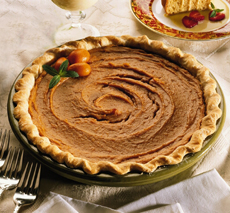
Pumpkin pie. Photo courtesy Wisconsin Milk Marketing Board. |
Continue To Page 9: Terms With Q To S
Go To The Article Index Above

|

















